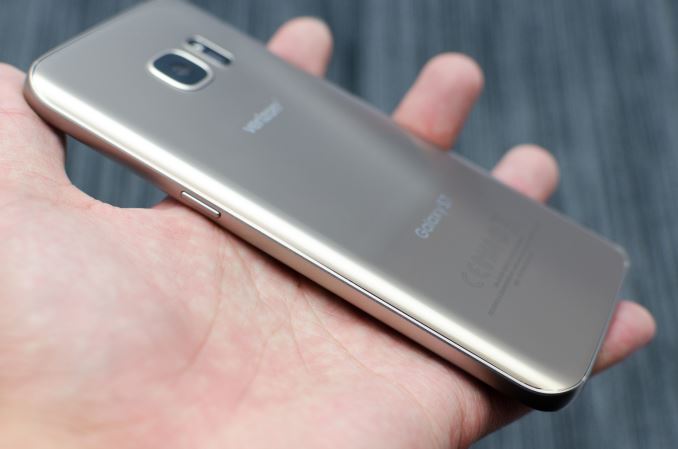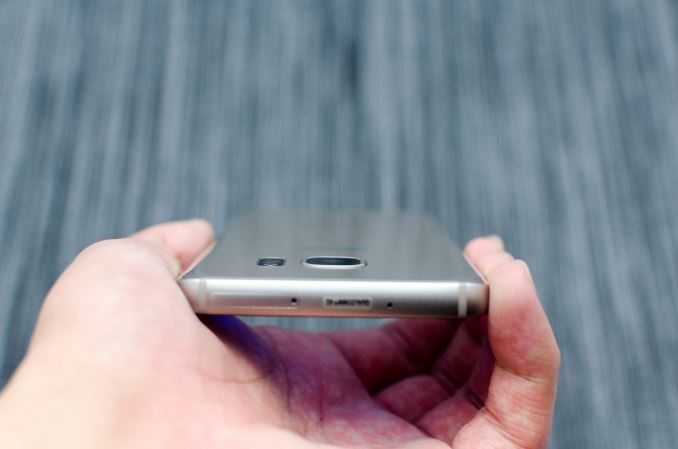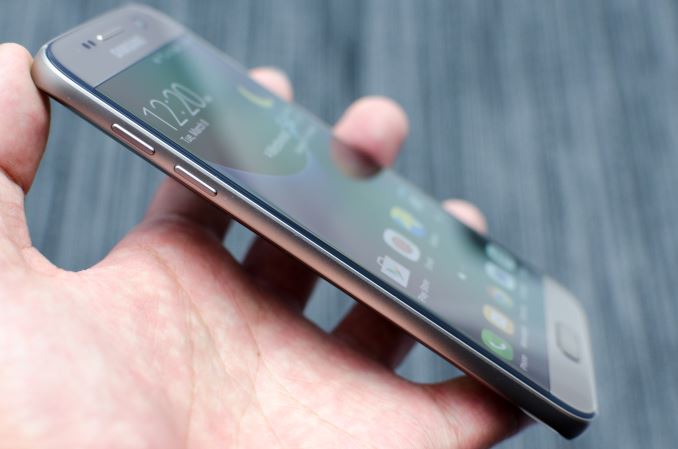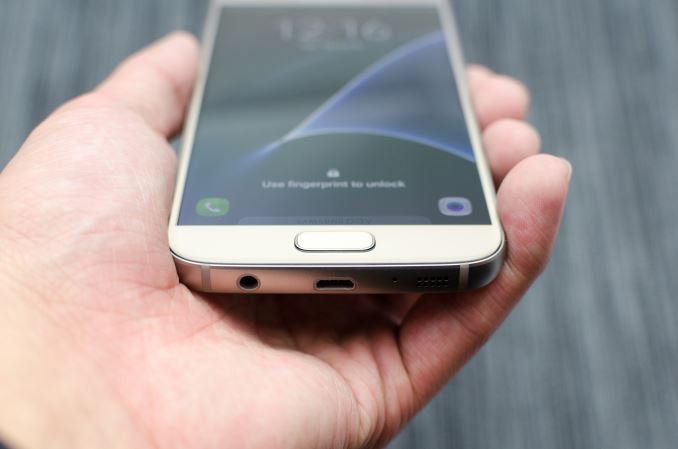The Samsung Galaxy S7 & S7 Edge Review, Part 1
by Joshua Ho on March 8, 2016 9:00 AM EST
For some time now, Samsung has been the dominant player in the Android space, especially at the high end of the market. From the Galaxy S2 onwards, Samsung has been able to ride the wave of the smartphone industry’s growth without much disruption. Samsung has also shown a pretty impressive ability to adapt to changes in the market as seen by their dramatic departure in materials from the Galaxy S5 generation to the Galaxy S6 generation. While the Galaxy S6 was ultimately one of the best phones you could get that year, at least a few design decisions like the loss of removable battery and microSD slot were generally considered to be a step back relative to previous devices.
Throughout their reign of dominance Samsung has always been able to stay on top, however their competition is never too far behind. To that end, it’s probably obvious now that the Galaxy S7 family represents an attempt to improve on the Galaxy S6’s perceived faults, while building upon its perceived strengths. In order to start discussing these changes, we can start by looking at the basic specs and design of the Galaxy S7 and S7 edge.
| Samsung Galaxy S Family | |||||
| Samsung Galaxy S7 | Samsung Galaxy S7 edge | Samsung Galaxy S6 | Samsung Galaxy S6 edge | ||
| SoC | Snapdragon 820 (US, China, Japan) 2x Kryo @ 2.15GHz 2x Kryo @ 1.6GHz Adreno 530 Exynos 8890 (Rest of World) 4x A53 @ 1.58GHz 4x Exynos M1 @ 2.28-2.60GHz Mali T880MP12 @ 650MHz |
Exynos 7420 4x Cortex-A57 @ 2.1GHz 4x Cortex-A53 @ 1.5GHz Mali T760MP8 |
|||
| RAM | 4GB LPDDR4-3600 | 3GB LPDDR4-3100 | |||
| NAND | 32/64GB NAND (UFS) + microSD |
32/64/128GB NAND (UFS) | |||
| Display | 5.1” 1440p SAMOLED |
5.5" 1440p SAMOLED Dual Edge |
5.1” 1440p SAMOLED |
5.1” 1440p SAMOLED Dual Edge |
|
| Network | S820: Qualcomm X12 Integrated 2G / 3G / 4G LTE (Category 12/13) |
2G / 3G / 4G LTE (Category 6) | |||
| Dimensions | 142.4 x 69.6 x 7.9 mm, 152 grams | 150.9 x 72.6 x 7.7 mm, 157 grams | 143.4 x 70.5 x 6.8mm max, 138 grams | 142.1 x 70.1 x 7.0mm max, 132 grams | |
| Camera | Rear Camera w/OIS 12MP (4032 x 3024) Sony IMX260 f/1.7, object tracking AF |
Rear Camera w/OIS 16MP (5132 x 2988) Sony IMX240 / Samsung S5K2P2 f/1.9, object tracking AF |
|||
| Front Facing 5MP, f/1.7 |
Front Facing 5MP , f/1.9 |
||||
| Battery | 3000mAh (11.55 WHr) | 3600mAh (13.86 WHr) | 2550 mAh (9.81 WHr) | 2600 mAh (10.01 WHr) | |
| Launch OS | Android 6 w/TouchWiz | Android 5 w/TouchWiz | |||
| Connectivity | 802.11a/b/g/n/ac 2x2 MU-MIMO + BT 4.2, USB2.0, GPS/GNSS, NFC |
2x2 802.11a/b/g/n/ac + BT 4.1 (BCM4358), USB2.0, GPS/GNSS, NFC |
|||
| Wireless Charging | Yes, Fast Charging | WPC 1.1 (4.6W) & PMA 1.0 (4.2W) |
|||
| Fingerprint Sensor | Touch | Touch | |||
| SIM Size | NanoSIM | NanoSIM | |||
| Launch Price (No Contract) |
$650+ USD | $750+ USD | $650+ USD |
$750+ USD |
|
One of the other major changes in terms of design this time around is electing to go with a significantly larger battery than before. Compared to most other aspects of smartphone technology, battery technology is a more mature field and improves as a slower pace, so the tradeoffs made here result in a thicker device and increased weight relative to the Galaxy S6. However, as we’ll soon see Samsung has made a number of changes in the industrial design which help to mitigate these issues.
Meanwhile, with the Galaxy S7 generation, Samsung has further blurred the line between the Galaxy S lineup and the Galaxy note. The Galaxy S7 edge is a 5.5-inch device - fully into the phablet territory - and only 0.2 inches smaller than the 5.7" Galaxy Note5. This means that the two Galaxy S7 phones are now more significantly differentiated than with the Galaxy S6 generation, where the difference amounted to the dual-edge display and a slightly larger battery. Now the Galaxy S7 edge is larger, ever so slightly heavier, and contains a battery with 20% more capacity than it's base Galaxy S7 brethren.
The final change of note in the Galaxy S7/S7 edge is the camera. With the Galaxy S6 review it was hard to avoid wondering why Samsung didn’t bother to integrate a camera with larger pixel size to improve low light performance, especially when camera was such a significant part of the Galaxy S6 design story with the noticeable camera hump. For the Galaxy S7, Samsung has gone ahead and done just this: the pixel size is now 1.4 micron which should significantly increase the number of situations where the image quality is limited by shot noise rather than image sensor noise. And to top things off the camera hump has now been almost entirely eliminated.
On a quick housekeeping note before we dive in, as we've had less than a week to look at the Galaxy S7, we're dividing up our review into two parts. Today we'll focus on the basics: performance, battery life, design, and the display. Part 2 will go deeper, looking into the Snapdragon 820 SoC in fuller detail, and coupling that with Wi-Fi performance, camera performance, and more.
Design
Now that we’ve gone over the high level changes of the Galaxy S7 and S7 edge, we can start talking about the design of the device. While the Galaxy S6 was an enormous departure from what we were used to seeing from Samsung, the Galaxy S7 is really more an evolution of the Galaxy S6 design. As previously mentioned, it is noticeably thicker and heavier than the Galaxy S6. However, to offset this increase in thickness Samsung has integrated the curved 3D glass of the Galaxy Note5 into the design of the Galaxy S7.
The result of this change is that the Galaxy S7 arguably feels much better in the hand than the Galaxy S6. While I didn’t really have huge issues with the ergonomics of the Galaxy S6, it definitely felt a bit blocky relative to something like the Xiaomi Mi Note Pro and didn’t quite fit in the hand as nicely. The weight increase is noticeable, but not really the end of the world.
The thickness does result in a noticeably reduced camera hump, but on a personal level I never really cared about the camera hump in the Galaxy S6, so I’m not sure I care about the reduction in the camera hump here. I would actually argue that a camera hump is preferable to a camera cover lens that is perfectly coplanar to the back of the phone, as it means that the camera lens isn’t contacting whatever surface I’ve set it down on. While sapphire cover lenses go a very long way to eliminating the potential for scratching a cover lens, there’s also the potential for oil to smear on the camera’s cover lens so I would actually prefer having a camera hump.
The other noticeable change here is the re-introduction of 2.5D curved glass on the edges of the display. I’m not quite sure why Samsung tends to remove and re-introduce this design element seemingly on and off, but it does help with improving the feel of edge swipes at the cost of complicating some things like screen protectors and glass lens durability. Honestly speaking, I’m not sure how much of a difference it makes either way, but it does remove another edge present in the design.
Other than these changes, the design is almost unchanged. The power button remains on the right side of the device and is well-positioned ergonomically. The volume buttons are pretty much in the same place on the left side as well. The 3.5mm jack, micro-USB port, and single speaker are all on the bottom of the device. The only notable deletion in terms of design elements here would be the loss of the IR port on top of the device, which was removed from Galaxy devices starting with the Note5.














202 Comments
View All Comments
sachouba - Tuesday, March 8, 2016 - link
Thanks for this review, it's quite good.But I don't understand why the brightness would have been lowered whereas other websites tell the contrary - and Samsung usually increases the maximum brightness on every flagship device.
Moreover, the web battery life test is not representative of actual battery life, because AMOLED displays are very disadvantaged in this test on white web pages, whereas the battery life would be much higher on websites with a lot of dark areas (photos, dark background, etc.).
Some browsers allow you to use a "night mode" which inverts the colors of websites background if the APL is high.
I hope you will review the Exynos version as well - I guess it will be much smoother and with a better battery life, as always.
JoshHo - Wednesday, March 9, 2016 - link
Our new web test has some pages with dark themes currently. However, the overwhelming majority of webpages and UI have a high average picture level. In order to reflect this the vast majority of our webpages are black text on a white background.We are hoping to get an Exynos unit to compare with the Snapdragon 820.
lilmoe - Wednesday, March 9, 2016 - link
Please use the stock browser with Ad block enabled for that test on the Exynos variant. Thanks.deskjob - Tuesday, March 8, 2016 - link
I am totally for prioritizing energy efficiency and battery life over a 100% fluid UI. But I also find it hard to believe that at this stage in the smartphone evolution, a flagship device still can't achieve that goal without adverse effect on battery life. I feel like in the S7's case, it's more likely than not that Samsung and their proprietary UI is at fault for the janky UI performance. Would love it if you guys have time to investigate this further! After all, I am not sure I am not alone in saying a smooth UI is a big part of the everyday smartphone experience.heartinpiece - Tuesday, March 8, 2016 - link
Wow Finally!Will you be reviewing the Exynos 8990 as well?
Seems like a comparison between the 820 and the 8990 would be interesting!
10basetom - Tuesday, March 8, 2016 - link
I can't wait for a detailed comparison between the Snapdragon 820 and Exynos 8890 once you have both S7 models in hand.SydneyBlue120d - Wednesday, March 9, 2016 - link
Same old question, maybe in part 2 of the review we can get an answer: Is unlimited HEVC encoding at 2160p60 with both HDR and IOS supported? Thanks a lot.Osamede - Wednesday, March 9, 2016 - link
While its always interesting to see proper deep dive reviews, I find that these days there is nothing that would get me to buy another Samsung "flagship". Totally overpriced by strategically riding the slipstream of Apple's own boundless greed - except these ones do not hold value at all.s.yu - Friday, March 11, 2016 - link
You must be blind, choosing the recent iCrap over this. Apple's last good looking phone was the 5th generation.pjcamp - Wednesday, March 9, 2016 - link
You say people will find the stock Android interface "rather spartan." That strikes me as odd since I went from TouchWiz to an essentially stock Android on a Moto X Pure. I would never go back. Settings are located where they should be, not moved around at random. Customization is much easier. And stability is no longer an issue. I had, for instance, one major audiobook app that reliably crashed the system under TouchWiz to the point of needing a battery removal to get it restarted. I came to understand that TouchWiz, not the app, was the point of failure during the brief time I used Cyanogenmod and it worked fine. Also works fine on my Motorola.TouchWiz and other skins are not about operability. They are exercises in branding, equivalent to logos. Rather than being nonspartan, they are actually an impediment to usability. If you go to Google to find out how to do something, the instructions will be different from how your skinned phone operates. Sometimes it is easy to translate, sometimes not.
For a lot of people, that probably doesn't matter. But for a lot of people, introducing a skin introduces another potential point of failure, and another opportunity for vendors to point at each other in a circle should there ever be a problem.